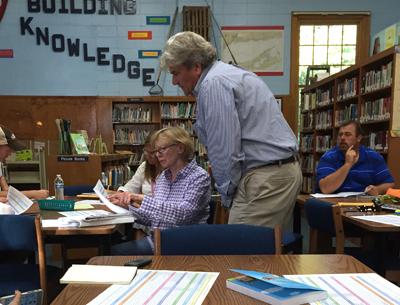Springs Committee to Recommend Bond

The Springs School facilities committee appears poised to recommend a multimillion-dollar bond referendum to pay for more portable classrooms or permanent classrooms, a new gym, and a science, technology, and arts laboratory, along with numerous infrastructure repairs. The committee will present its recommendations at the Oct. 5 school board meeting.
The committee, which consists of community members, parents, and school administrators and teachers, was not unanimous in its recommendation for a bond proposal. According to the results of a Sept. 16 questionnaire, which each member answered anonymously, 12 members agreed the school has a space problem and the questionnaire yielded a 10-to-2 tally in favor of a referendum. One member did not answer “yes” or “no.”
Considering how to deal with overcrowding in the school, the committee appeared divided on whether to bring prekindergarten students back on campus from the Most Holy Trinity Catholic School building in East Hampton. However, most members favored bringing kindergartners and firstgraders into the building from their current spaces in modular classrooms and Springs Youth Association buildings. To do so would require building more classrooms in or onto the school.
The committee fine-tuned its decision on Tuesday night, at which time it turned to the idea of adding more temporary portable classrooms. That was not among the recommendations made by Roger Smith of BBS Architects and Engineers, the Patchogue firm that assisted the committee during four meetings over the last four months.
Mr. Smith had previously projected that adding four temporary classrooms for three years would cost about $1.06 million, and said the project would under any circumstances take a few years to complete due to lengthy state approval and design and construction processes.
The committee grappled on Tuesday with its lack of a short-term solution.
“We know what we want, what we would like to see, but how do we get it faster than a five or six-year plan?” asked Jodie Hallman, a first-grade teacher at the school. “I would love to see if we could do it faster or in phases. These are things that, program-wise, we need.”
The committee has also struggled with whether a bond referendum would be well received. “I’m just concerned that we could have another referendum which the taxpayers in Springs aren’t going to go for. I think our referendum has to be on what we need, and not what we want. There has to be a prioritization,” said Susan Harder, a committee member. “I’m also trying to be realistic about what the community can handle.”
John J. Finello, the Springs superintendent, received a copy of the results of the committee’s questionnaire last week. In an interview Tuesday, Mr. Finello said, “We appreciate the findings of the committee and look forwardo discussing it with the board.”
The committee began developing its report the same week the school board president acknowledged there may have been a misstep with its interactions with BBS Architects, which has been helping Springs deal with its space problem since early 2014.
In an email last week, Liz Mendelman, president of the Springs School Board, confirmed that the board never passed a resolution approving payment to BBS Architects for a spatial analysis of the school and related architectural designs. “It was an oversight,” she said.
According to a Jan. 20, 2014, letter from the firm to Mr. Finello, the initial project was to cost $8,000. However, the invoices sent from BBS Architects to the school, obtained by Freedom of Information Act request, show the work expanding in scope and rising in cost from the start.
The district’s first payment amounted to more than $12,000 and subsequent invoices totaled more than $34,000. There was no discussion of a cap on the cost, Mr. Smith said by phone yesterday. The school has only paid the firm about $26,500 so far. The district had $3,000 budgeted for architectural services during the 2013-14 school year, but, in addition to BBS, it spent $5,060 for work by Chaleff and Rogers of Water Mill for the renovation of the front entrance of the school. The extra architectural expenses were covered by a capital reserve fund.
BBS Architects has worked free of charge since May, when two of its architects began working with the Springs facilities committee.
Mr. Finello has consistently praised Mr. Smith, with whom he had worked while superintendent of the Huntington School District. On Tuesday, he declined to comment on the resolution oversight or rising project costs.
In an email this week, Ms. Mendelman explained that Mr. Smith and his team publicly presented the proposed spatial analysis and related concept proposal during the Feb. 10, 2014, board meeting “prior to the board voting on a resolution.”
“It was an oversight that the resolution was not on the agenda,” she wrote. “If there are any outstanding/unpaid invoices for BBS, then the board would need to have a resolution to authorize payment.”
